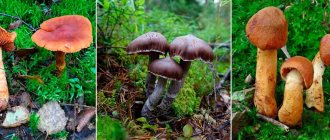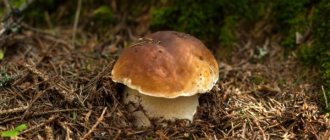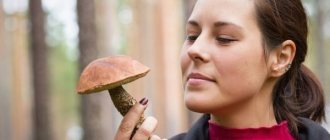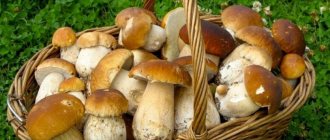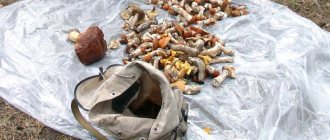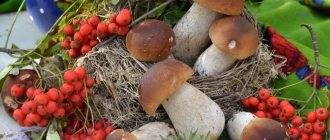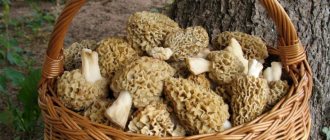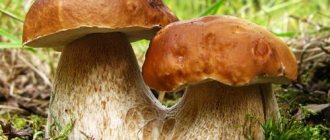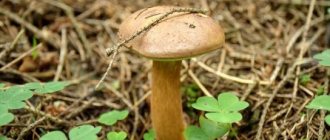What mushrooms grow in late autumn. Autumn mushrooms. Collection rules
There are many people who want to combine a walk in the forest with searching for mushrooms. But not everyone knows the rules and features of the collection. Get to know the intricacies of “silent hunting”.
mushroom places
The art of searching for mushrooms can be learned by following advice and studying natural features that affect the growth of mycelium. experience comes gradually with knowledge of the specifics of the soil, vegetation cover and terrain. it is important to take into account combinations of trees, the presence of moss, grass, pine needles, and access to the sun. favorable places in the lowlands, at the edge of the forest. you need to “hunt” in a birch-spruce, pine forest with a nutrient medium for mycelium - this is a litter of old leaves and humus. where there is tall grass, no sunlight, no ravines, no hills, a thick old spruce forest - this is not a place for a mushroom picker, it is useless to look here. Everyone's search is structured differently. Some look under the overhanging spruce branches and walk around isolated birch trees along the edge of the forest. Someone is searching on the edges and clearings, examining the grass. In any case, attention and slowness are required.
The signs are a light forest, a clearing, although each mushroom has certain places to grow. For example, in old pine forests you will find a lot of greenfinches. Boletuses and boletuses love to grow in birch forests mixed with young fir trees. In the hazel and aspen groves you will find an abundance of pigs and black milk mushrooms. Many species prefer dense soil with short grass. For boletus they go to pine and spruce forests, where there is a lot of moss. Places covered with morning fog and lowlands are signs of saffron milk caps, boletus, and chanterelles. Mushroom spots are often identified by their mushroom smell.
Autumn mushrooms
Heavy rains, lack of heat, high humidity, and cool nights are characteristic features of autumn and favorable conditions for mushrooms.
Mushrooms in September In September, the active time of mushroom pickers begins - this is the height of picking and delicacy preparations. At this time, summer myceliums continue to bear fruit and autumn species appear: rows (smoky, purple, poplar), honey mushrooms, talkers, saffron milk caps, svinushki, greenfinches, nigellas. Intensive growth of boletuses, moss caps, birch boletuses, and puffballs is observed. There are a lot of russula, umbrella mushrooms, and boletus mushrooms (Polish mushroom). Mushrooms in October The lush palette of the October forest adds mystery and creates a fabulous feeling. The ground is covered with multi-colored foliage in the form of a dense blanket, under which mushrooms are hidden. During this time, the number of growing varieties decreases. The myceliums of honey fungus, boletus, black milk mushrooms, goats, talkers, russula, rows, and greenfinches continue to bear fruit.
Cold creeping fogs are unfavorable for mushroom flies; they disappear, allowing the mushrooms to remain intact until adulthood. The October harvest is good for processing and drying: heating is already working in houses, and pickles are well preserved on terraces and balconies until persistent frosts. Mushrooms in November Gray row mushrooms, autumn oyster mushrooms, greenfinches, nigella are collected before the onset of frost. On stumps and fallen trunks covered with frost, winter honey mushrooms continue to grow together; these colonies have a reddish color. After the onset of constant night frosts, the mushroom season ends.
Rules for mushroom pickers
1. Beginner mushroom pickers need to study the table of edible mushrooms and it is advisable to make their first trips to the forest with experienced friends. 2. Never collect questionable mushrooms or those that are unknown to you. 3. Do not take overripe, moldy mushrooms or those with signs of decay. 4. To simplify the search, it is recommended to walk with a small stick (90-100 cm) and maintain a slow pace. 5. The container must be correct: a basket, a wicker basket. Mushrooms need to breathe, so bags and buckets are not the best option. 6. Clothing should be closed and inaccessible to insects and ticks. Shoes - comfortable for long walks (sneakers, boots). 7. Mushrooms with tubular caps are folded with their legs down. For large specimens, it is better to immediately cut off the head and place it separately. 8. To facilitate home recycling, it is better to clean the dirt immediately and not put it with the ground. 9. During collection, be sure to monitor your movements using a compass or navigate by the sun and cardinal directions. Otherwise, you can get lost in an unfamiliar forest.
when to go mushroom picking
It is impossible to name the exact time, since the sun rises differently in summer and autumn. You need to enter the forest while the morning sun glides across the grass at an acute angle. a long shadow makes it easier to spot the mushroom. In dry weather, mushroom picking is useless. They begin to appear after rains, with good soil moisture, and warm fogs. In the middle zone, the mushroom season begins early: at the beginning of May, morels and strings are already growing. The largest collections of all types occur in August - September.
False honey mushrooms
Inedible mushrooms are the main danger during “silent hunting”. The beneficial variety has a poisonous counterpart called the false one . They look similar in appearance, but inedible mushrooms cause poisoning.
They can be distinguished by the following characteristics.
| Description | Edible view | Inedible species |
| A cap | Light brown, with scales | Brighter shade, such as reddish or yellowish, without scales |
| Plates | Light beige | Green or olive tint |
| Leg | There is a leathery ring and scales | No leathery ring or scales |
| Aroma | Typical mushroom | Putrid or earthy |
Important! Some “bad” species are conditionally edible - they do not cause poisoning, but they are not beneficial either. Therefore, it is better to focus on the appearance of “good” mushrooms.
Honey mushrooms are easy to harvest if you know where to look for them. Inspect stumps and trees - this type of mushroom will most likely grow on them. However, pay attention to all the characteristics of the fruiting bodies listed above. Edible species are easily confused with poisonous ones, and this is fraught with health problems.
What kind of mushroom grows under the Christmas tree? Top 7 autumn edible mushrooms that are not collected in Russia
Expanding our horizons. Today the top 9 mushrooms are collected by only 15 percent of experienced mushroom growers. Each mushroom is interesting in its own way. Let's say a few words about each.
Smoky talker
Smoky talker is an autumn mushroom. The mushroom is very controversial, I would say that it is not for everyone. It has a strong smell that goes away after boiling. It causes severe intestinal upset in some people, and some eat it in bulk. Therefore, all those who collect this mushroom must boil it for 15 minutes and drain the water.
Common scalyfoot
Also refers to autumn mushrooms. Loves to grow on rotten wood. The name speaks for itself. The cap has scales. The cap can grow up to 12 cm in diameter. Edible mushroom, after boiling for 20 minutes.
Spruce weed
Edible mushroom. It contains more protein than porcini mushrooms. The cap is always covered with mucus. Grows under fir trees.
Yellow hedgehog
Refers to edible mushrooms. It is fried, steamed, dried, salted, boiled, and made into cutlets. They collect it separately from the others so that the spines do not come off. You can see them in the photo.
Stropharia blue-green
Grows in coniferous and mixed forests. Grows singly or in bunches in autumn. A very unusual color of the hat, like something out of a fairy tale. Edible mushroom after preliminary boiling.
Hygrophorus pimply
Late autumn mushrooms. Edible mushroom. It is collected in the forest when there is nothing to take. Because hygrophor is small in size. It tastes sweetish.
Fly agaric gray - pink
This mushroom is considered a delicacy. One of the best mushrooms when fried. It is important to be able to distinguish them from their poisonous brothers. It is especially often confused with the panther fly agaric. The gray-pink fly agaric has pink shades, the caps have gray and brown dots, but not white.
Edible or not
Most types of mushrooms can be eaten . However, you need to be careful when collecting. One specific species is not systematized under a general name. This is a popular name that unites outwardly similar varieties of mushrooms that, according to mycological descriptions, belong to different genera. Honey fungus can be both edible and inedible . “Good” varieties are distinguished from “bad” ones by characteristics - cap, stem, ring, smell.
Important! Do not collect rotten honey mushrooms. Experienced mushroom pickers advise cutting off a spoiled mushroom and hanging it on a branch with the cap down so that the air can spread the spores throughout the forest.
What mushrooms grow in a pine forest. Rows
The rows got their name due to their ability to grow in large groups, which are arranged in a row or in circles. The cap of young mushrooms has the shape of a ball, cone or bell, the color is different: white, yellow, green, red, brown. There are plates under the cap, the leg can be bare or covered with scales, but the color is the same - pink-brown.
Where and when do they grow?
They grow in the temperate zone, prefer coniferous trees, more often pine. They may prefer spruce and fir. Rarely found near oak, birch or beech. They grow from late summer until frost.
Are there varieties?
The row includes about 100 species of mushrooms; it is worth mentioning the most common ones.
- Gray. The color of the cap is gray with a greenish or purple tint, smooth. The leg is white, with a yellow or gray tint. Grows from September to November.
- Scaly. The name speaks of its distinctive features, the surface is covered in scales. Grows in groups in coniferous and deciduous forests.
- Earthy. The cap is gray or gray-brown, sometimes reddish-brown, with a tubercle in the center. The leg is white. It grows only in coniferous forests, from August to October.
- Yellow-brown. The cap is convex, with a tubercle, red-brown. The leg is white above, brownish below.
- Mitsutake. Or pine mushroom, valued in Korean and Japanese cuisine. The cap and leg are brown, the smell of the pulp is reminiscent of cinnamon.
- Crowded. The cap looks like a pillow and opens up on mature mushrooms. The leg is twisted, the color is from white to brown.
- Poplar. Reproduces by spores in plates. The color of the cap is red and resembles a hemisphere. The leg is pink and white, if you press, spots appear.
- Violet or lilac-legged. The name speaks about its distinctive features. It grows in groups in deciduous forests where there are more ash trees. Harvest months are from April to November.
Description
Honey mushroom is the collective name for a category of forest mushrooms, which includes 34 different species.
Did you know? Edible mushrooms, growing on living stumps and trees, glow in the dark thanks to bioluminescence. The light is emitted by the plates and fibers of the mycelium.
The most common varieties:
- winter;
- summer;
- autumn;
- meadow.
The general description of all varieties is similar. The cap is lamellar, round in shape, sometimes with wavy edges. The average diameter is 5 cm, can vary from 2 to 15 cm. The fruiting bodies of the first years of life are distinguished by a convex cap, the old ones become flat.
The color of the peel is light brown in different shades, from honey to ocher . The edges are often light, the center darker. The peel is smooth, in many varieties it is covered with scales. The flesh of the cap is light and thin. The plates are light beige, sometimes closer to white, sparse, growing to the stem.
Did you know? Honey mushrooms grow as quickly as bamboo, but unlike bamboo, they grow only to a certain level. The rate of development is 0.5 cm per minute.
The legs are light brown, grow from 2 to 10 cm in height, with a diameter of 1–2 cm. The shape is cylindrical, sometimes slightly sinuous. The pulp is fibrous. The leg is covered with scales. Most species have a leathery ring.
Spore powder is white or light brown. The mycelium of the honey fungus is fibrous, grows together with trees - this species is considered a parasite because it grows on other living organisms. The mycelium grows up to a meter deep. At home, this type of mushroom is also grown on stumps, although they can also be grown in greenhouses .
general characteristics
About 200 species of mushrooms grow in the forests of our country, but only 40 species of them can be eaten by humans. The energy value of the product is low, about 300-500 calories per 1 kg. The chemical composition of the fungus is close to vegetable crops, despite the fact that the set of amino acids is similar to products of animal origin.
What mushrooms grow under pine trees? These are porcini mushrooms, saffron milk caps, pig mushrooms, russula, Polish mushrooms, boletus mushrooms, green mushrooms, mokrukha and fly agaric mushrooms. In spruce forests you can find porcini mushrooms, butterfly mushrooms, spruce mushrooms, garlic mushrooms, forest champignons, puffballs and yellow milk mushrooms.
Ryzhik
Camelina is one of those mushrooms that grow under pine and spruce. There is pine camelina, which has an orange or red-orange cap. Spruce camel has a yellowish or lilac-greenish tint. The fruiting individuals of this species are covered with mucus. When you cut or touch it, green spots appear. It has a pronounced smell of milky juice.
Spruce mushrooms feel best in places where moss grows, there are small hummocks, and also near lingonberries and blueberries.
The pine species is most often found in drier areas of the forest, on small hills near young pines.
The mushroom is best suited for marinating and frying in sour cream.
Answers to common questions
Forest mushrooms attract lovers of delicious food, but also raise many questions. It is useful to listen to the opinion of a specialist answering some of them.
But the most effective technique is to soak the mushroom bodies in water with salt and citric acid. Then, along with the sand, a lot of other debris will separate, including pests hiding in the folds. True, you shouldn’t keep it in water for a very long time; half an hour will be enough. The pulp absorbs moisture very strongly, which reduces the taste.
The pine forest is both a hospital with healing air, and a home for many animals, and a storehouse of nutritious fruits for both animals and people. On a quiet hunt you need to be careful with edible mushrooms.
Any walk in a coniferous or pine forest will not be complete without contemplating or picking mushrooms. They all have an underground part, which is small tiny threads of epithelium. Mushrooms are not able to produce chlorophyll like plants, so they are highly dependent on their environment. It is from rotting leaves and decomposing remains of living beings that they consume all the necessary substances for growth and development. Coniferous forests are rich in organic matter.


